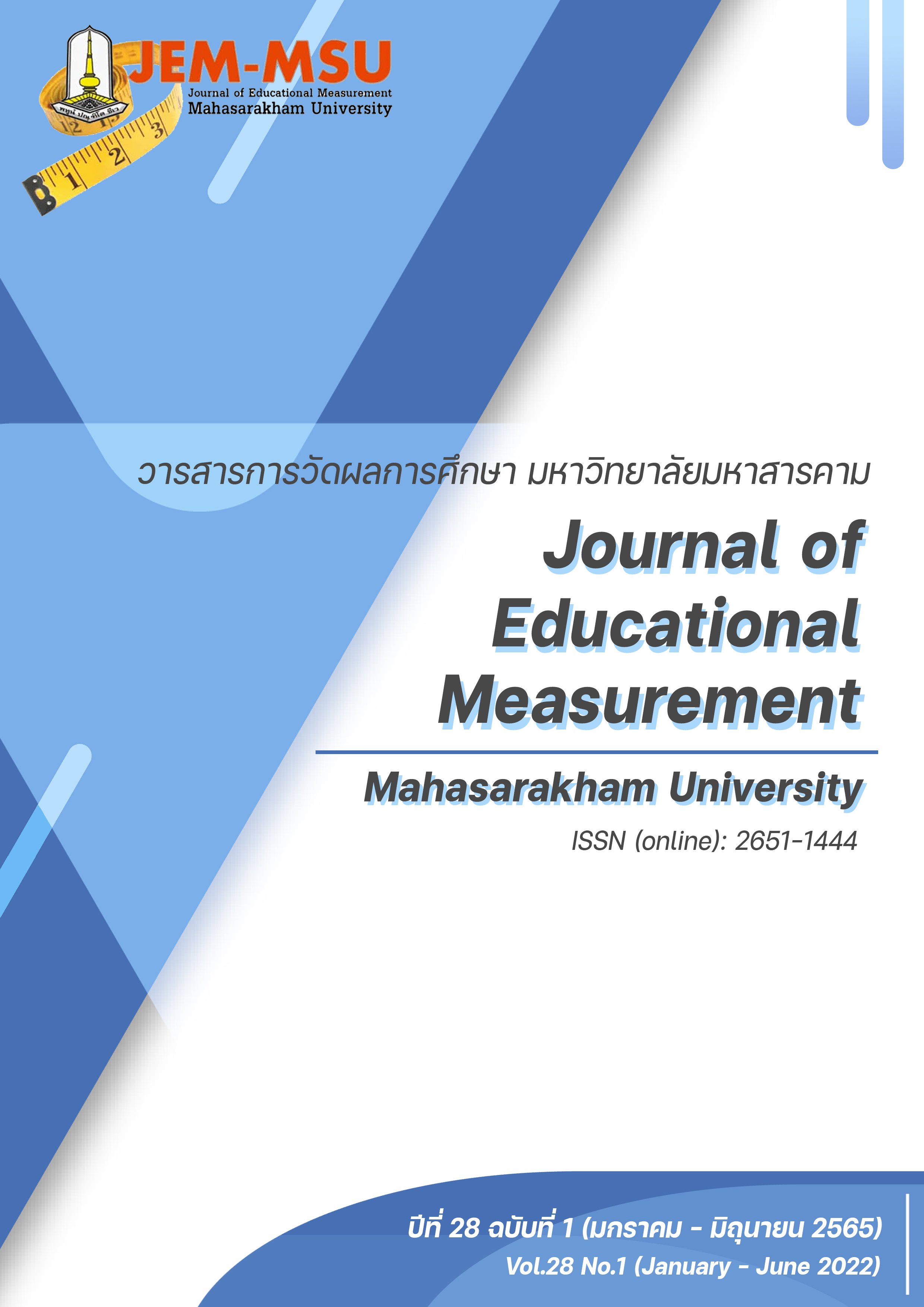การพัฒนาแบบวินิจฉัยและชุดกิจกรรมเสริมสร้างความสามารถด้านการอ่านและเขียนภาษาไทย สำหรับนักเรียนชั้นประถมศึกษาปีที่ 3
Main Article Content
บทคัดย่อ
การวิจัยครั้งนี้มีวัตถุประสงค์เพื่อ 1) เพื่อพัฒนาและหาคุณภาพแบบของแบบวินิจฉัยความสามารถด้านการอ่านและเขียนภาษาไทย สำหรับนักเรียนชั้นประถมศึกษาปีที่ 3 2) เพื่อหาประสิทธิภาพของชุดกิจกรรมเสริมสร้างความสามารถด้านการอ่านและเขียนภาษาไทย สำหรับนักเรียนชั้นประถมศึกษาปีที่ 3 ให้มีประสิทธิภาพตามเกณฑ์ 80/80 3) เพื่อเปรียบเทียบความสามารถด้านการอ่านและเขียนภาษาไทยของนักเรียนชั้นประถมศึกษาปีที่ 3 ระหว่างก่อนเรียนและหลังเรียนที่เรียนด้วยชุดกิจกรรมเสริมสร้างความสามารถด้านการอ่านและเขียนภาษาไทย กลุ่มตัวอย่างในการวิจัยครั้งนี้ คือ นักเรียนระดับชั้นประถมศึกษาปีที่ 3 โรงเรียนประถมศึกษาในสังกัดสำนักงานเขตพื้นที่การศึกษาประถมศึกษานนทบุรี เขต 2 ที่กำลังศึกษาในปีการศึกษา 2563 จำนวน 357 คน ด้วยการสุ่มแบบหลายขั้นตอน (multi-stage random sampling) โดยใช้การกำหนดขนาดของกลุ่มตัวอย่าง ของเครซี่และมอร์แกน เครื่องมือที่ใช้ในการวิจัย ประกอบด้วย 1) แบบสํารวจข้อบกพร่องด้านการอ่านและเขียนภาษาไทยของนักเรียนระดับชั้นประถมศึกษาปีที่ 3 2) แบบวินิจฉัยความสามารถด้านการอ่านและเขียนภาษาไทย สำหรับนักเรียนชั้นประถมศึกษาปีที่ 3 3) ชุดกิจกรรมเสริมสร้างความสามารถด้านการอ่านและเขียนภาษาไทยสำหรับนักเรียนชั้นประถมศึกษาปีที่ 3 จำนวน 10 ชุด 4) แบบทดสอบวัดความสามารถด้านการอ่านและเขียนภาษาไทย สำหรับนักเรียนชั้นประถมศึกษาปีที่ 3 จำนวน 2 ฉบับ คือ แบบทดสอบก่อนเรียนและแบบทดสอบหลังเรียน
ผลการวิจัย พบว่า
1. แบบวินิจฉัยความสามารถด้านการอ่านและเขียนภาษาไทย สำหรับนักเรียนชั้นประถมศึกษาปีที่ 3 ทั้ง 10 ชุด มีความเที่ยงตรงเชิงเนื้อหา ตั้งแต่ 0.8-1.00 ค่าความยากง่าย ตั้งแต่ 0.20-0.80 ค่าอำนาจจําแนก ตั้งแต่ 0.20-0.80 และค่าความเชื่อมั่น มีค่า 0.80-0.85
2. ประสิทธิภาพของชุดกิจกรรมเสริมสร้างความสามารถด้านการอ่านและเขียนภาษาไทยสำหรับนักเรียนชั้นประถมศึกษาปีที่ 3 มีประสิทธิภาพ 82.50/81.33 เป็นไปตามเกณฑ์
3. ผลการเปรียบเทียบความสามารถด้านการอ่านและเขียนภาษาไทยของนักเรียนชั้นประถมศึกษาปีที่ 3 หลังเรียนสูงกว่าก่อนเรียน อย่างมีนัยสําคัญทางสถิติที่ระดับ .05
Article Details

อนุญาตภายใต้เงื่อนไข Creative Commons Attribution-NonCommercial-NoDerivatives 4.0 International License.
เนื้อหาและข้อมูลในบทความที่ลงตีพิมพ์ในวารสารการวัดผลการศึกษา มหาวิทยาลัยมหาสารคาม ถือเป็นข้อคิดเห็นและความรับผิดชอบของผู้เขียนบทความโดยตรง ซึ่งกองบรรณาธิการวารสาร ไม่จำเป็นต้องเห็นด้วย หรือร่วมรับผิดชอบใดๆ
บทความ ข้อมูล เนื้อหา รูปภาพ ฯลฯ ที่ได้รับการตีพิมพ์ในวารสารการวัดผลการศึกษา มหาวิทยาลัยมหาสารคาม ถือเป็นลิขสิทธิ์ของวารสารการวัดผลการศึกษา มหาวิทยาลัยมหาสารคาม หากบุคคลหรือหน่วยงานใดต้องการนำทั้งหมดหรือส่วนใดส่วนหนึ่งไปเผยแพร่ต่อหรือกระทำการใดๆ จะต้องได้รับอนุญาตเป็นลายลักษณ์อักษรจากวารสารการวัดผลการศึกษา มหาวิทยาลัยมหาสารคาม ก่อนเท่านั้น
เอกสารอ้างอิง
Adams, G. S. and Theodose, L. T. (1964). Measurement and Evaluation in Education on Psychology and guidance. Rinehart and Winston.
Bloom, B. S. (1971). Hand Book on Formation and Summative Evaluation of Student Learning. McGraw-Hill.
Bureau of Academic Affairs and Educational Standards, Office of the Basic Education Commission, Ministry of Education. (2015). First Semester of 2015 Academic Year Shows that 11% of Grade 1 Students are Having “Illiteracy Discourse” Worrying that Primary Level will Learn much Slower. http://www.educationnews.in.th/30614.html (in Thai)
Department of Education. (2018). Illiteracy Discourse in Children. https://th.theasianparent.com/Illiteracy Discourse in Children. (in Thai)
Nonthaburi Primary Education Service Area Office 2. (2019). Program for Solving Illiteracy Discourse in Children, Academic Year 2019. http://www.nonedu2.net/nonedu2/ (In Thai)
Office of the Basic Education Commission, Ministry of Education. (2018). ROADMAP Key points Toward Improving Students Proficiency for Escalating Curriculum, Learning Management, and Educational Measurement and Evaluation. http://nptedu.go.th/nites/academy /student%20developing.pdf (in Thai)
Pathumsuth, S. (2012). Easy Ways to Help Kids to Read (New) (12th ed). Nawasarn Printing. (in Thai)
Sakonrak, S. (2017). A Study of Teaching Methods and Comparative Analysis of the Achievement of Reading and Writing Thai Language Teaching at the Elementary Level in the Reign of King Rama 9. Chulalongkorn University Press. (in Thai)
Sinthapanon, S. (2008). Educational Measurement. Prasan Printing. (in Thai)
Srisa-ard, B. (2010). Basic Research (8th ed.). Suweeriyasan. (in Thai)
Sucheewa, S. (2007). Weakness and Strength Analysis of Learners. In Wongwanich, S. (Eds), New assessment of learning (2nd Ed.). Chulalongkorn University. (in Thai)
Sukhothhai Thammathirat Open University. (2008). Curriculum Development and Instructional Media (2th ed.). Sukhothhai Thammathirat Open University Press. (in Thai)
Tongaht, C. (2014). Illiteracy Discourse: Substantial problem-solving solutions. https://www.gotoknow.org/posts/579593. (in Thai)


